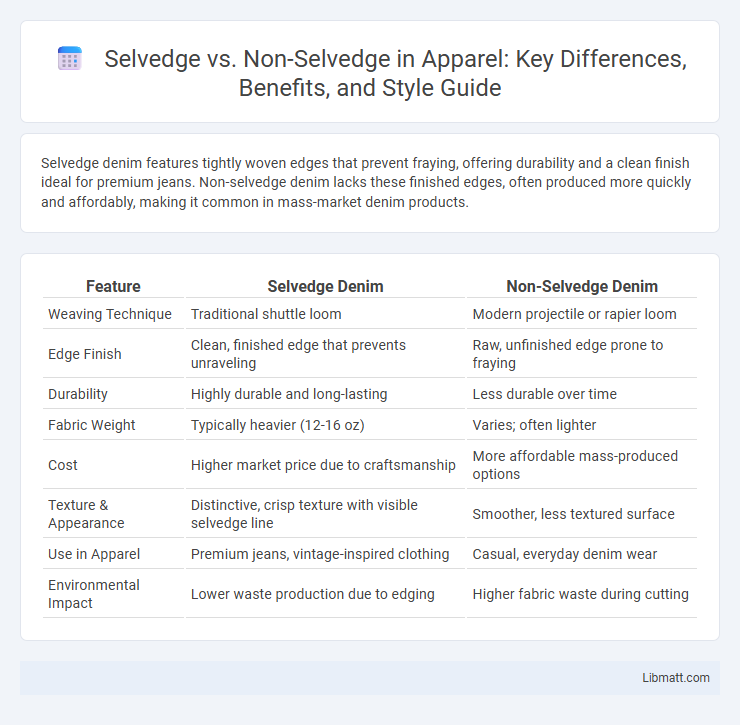Selvedge denim features tightly woven edges that prevent fraying, offering durability and a clean finish ideal for premium jeans. Non-selvedge denim lacks these finished edges, often produced more quickly and affordably, making it common in mass-market denim products.
Table of Comparison
| Feature | Selvedge Denim | Non-Selvedge Denim |
|---|---|---|
| Weaving Technique | Traditional shuttle loom | Modern projectile or rapier loom |
| Edge Finish | Clean, finished edge that prevents unraveling | Raw, unfinished edge prone to fraying |
| Durability | Highly durable and long-lasting | Less durable over time |
| Fabric Weight | Typically heavier (12-16 oz) | Varies; often lighter |
| Cost | Higher market price due to craftsmanship | More affordable mass-produced options |
| Texture & Appearance | Distinctive, crisp texture with visible selvedge line | Smoother, less textured surface |
| Use in Apparel | Premium jeans, vintage-inspired clothing | Casual, everyday denim wear |
| Environmental Impact | Lower waste production due to edging | Higher fabric waste during cutting |
Introduction to Selvedge and Non-Selvedge Denim
Selvedge denim features tightly woven edges that prevent unraveling, produced on traditional shuttle looms, which creates a distinctive, clean finish often sought after in premium jeans. Non-selvedge denim is made on modern projectile or rapier looms, resulting in a rougher edge that requires stitching to prevent fraying, making it more mass-produced and affordable. The difference in loom technology directly affects the fabric's durability, texture, and aesthetic appeal.
What is Selvedge Denim?
Selvedge denim is a type of denim fabric woven on traditional shuttle looms, producing tightly woven, self-finished edges that prevent fraying. These edges, known as "selvedge," are characterized by a clean, finished strip often visible when the jeans are cuffed. Selvedge denim is prized for its durability, superior quality, and the distinctive vintage look it imparts compared to non-selvedge denim woven on modern projectile looms.
What is Non-Selvedge Denim?
Non-selvedge denim is produced on modern shuttleless looms, resulting in fabric edges that do not have the tightly woven, finished borders characteristic of selvedge denim. Without these clean edges, non-selvedge denim is typically cut with stitched seams to prevent fraying, often leading to a wider range of fabric widths and more flexible design options. When choosing between the two, your preference for traditional craftsmanship or modern manufacturing techniques will influence whether non-selvedge denim fits your style and durability needs.
Key Differences Between Selvedge and Non-Selvedge
Selvedge denim features tightly woven edges that prevent unraveling and provide a clean, finished look, commonly identified by a colored thread along the fabric's edge. Non-selvedge denim, produced on modern shuttle-less looms, lacks these self-finished edges and is often cut and sewn with a factory-stitched seam. Choosing between selvedge and non-selvedge affects durability, aesthetic appeal, and price, with selvedge denim typically favored for its craftsmanship and long-lasting quality.
The Manufacturing Process: Selvedge vs Non-Selvedge
Selvedge denim is produced on traditional shuttle looms that weave tightly bound edges, preventing fraying and providing a clean, finished strip on the fabric's side. Non-selvedge denim, typically made on modern projectile or rapier looms, creates fabric with cut edges that require overlocking or serging to avoid unraveling. The slower, labor-intensive shuttle weaving yields a denser, more durable fabric in selvedge denim, whereas non-selvedge denim prioritizes higher production speed and volume, often resulting in a lighter, less robust material.
Durability and Quality Comparison
Selvedge denim is woven on traditional shuttle looms, creating tightly bound edges that prevent fraying and enhance durability compared to non-selvedge denim made on modern projectile looms with unfinished edges. The superior craftsmanship of selvedge denim results in a denser, longer-lasting fabric that maintains its shape and resists wear over time, offering higher quality and longevity. Choosing selvedge denim means investing in premium construction that delivers both durability and a refined finish, giving your wardrobe lasting value.
Visual and Aesthetic Differences
Selvedge denim features tightly woven edges with a clean, finished look often characterized by a distinctive colored line, usually red or white, running along the outer seams, enhancing garment durability and style appeal. Non-selvedge denim has open edges treated with overlock or pinked seams, resulting in a rougher finish that may fray over time, lacking the crisp, minimalist appearance Selvedge denim provides. The visible, narrow selvedge line on cuffs or inner seams adds a premium, vintage-inspired aesthetic preferred in high-end denim fashion.
Price Differences and Value for Money
Selvedge denim typically commands a higher price due to its traditional shuttle loom production, superior craftsmanship, and durability compared to non-selvedge denim made on modern projectile looms. The value for money in selvedge denim lies in its longevity, unique fading patterns, and premium quality, attracting enthusiasts willing to invest in authentic, long-lasting jeans. Non-selvedge denim offers more affordable options for casual wear but lacks the heritage and distinctive aesthetic that justify the higher costs of selvedge jeans.
Choosing the Right Denim for You
Choosing the right denim depends on your preference for durability and style; selvedge denim features tightly woven edges that prevent unraveling, offering a premium, long-lasting fabric ideal for high-quality jeans. Non-selvedge denim, often produced on modern shuttleless looms, provides a softer feel and usually comes at a more affordable price point, making it suitable for everyday wear. Understanding the differences in weaving techniques and edge finishes helps you select denim that aligns with your lifestyle and fashion needs.
Conclusion: Selvedge vs Non-Selvedge – Which is Better?
Selvedge denim is prized for its durability, clean finish, and unique edge that prevents unraveling, making it a top choice for premium jeans. Non-selvedge denim offers greater affordability and availability, often with more stretch and variety, appealing to casual wearers. Choosing between selvedge and non-selvedge depends on the desired balance of quality, price, and style preferences.
selvedge vs non-selvedge Infographic

 libmatt.com
libmatt.com